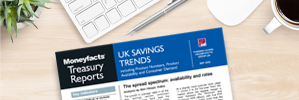Rachel Springall, Finance Expert at Moneyfacts, said:
“Savers will be disappointed to see variable savings rates plunge to a two-year low. The downward momentum is an inevitable turn of events, with providers adjusting their rates following on from four cuts to the Bank of England Base Rate since last summer (August 2024). Despite base rate falling, almost 90% of accounts are paying below it (4.25%). It is worth noting that it can take some time for providers to pass on cuts, depending on the type of institution, which is why savers must regularly review and switch their accounts. However, base rate cuts are not the only influence on pricing, most noted by the behaviours of challenger banks, which are determined to draw in deposits to fund their future lending.
“One method to grab the attention of consumers is to inflate a rate by offering a generous upfront bonus, sometimes propelling an account to the top of the market. As a result, the average bonus rate across all accounts has risen to the joint-highest on record, at 1.20%, and it’s been over a decade since there were as many bonus accounts of this kind. There might not be many bonus rate options on easy access or notice cash ISAs, but they are still being used to draw in new cash ISA customers. However, the generosity of such bonuses near the start of the new tax-year can tail off, and we have now had the biggest monthly fall in the average bonus rate on cash ISAs in more than a year. This makes it essential for savers to keep a note of when any bonus expires and to switch if the rate plummets as a result.
“The fixed rate market demonstrated its resilience in comparison to variable rates, despite swap rate volatility. This led to a multitude of providers readjusting their rates in response during June. However, the marginal rises to the average one-year bond and ISA rates might not be worth celebrating, particularly as the longer term outlook for interest rates looks uncertain. Despite minor rate moves, providers were busy with product churning once more, as the average shelf-life of a fixed rate bond fell to 44 days, from 49 days, down from the three-year high of 66 days back in March 2025. Reassuringly though, product choice across the savings spectrum continues to thrive, which is good news for consumers looking to spread their wealth. It is essential savers take advantage of the latest deals to surface, particularly if they want a guaranteed return on their cash. Savers should strive to take full advantage of their ISA allowance and their Personal Savings Allowance (PSA), in tandem with their search for returns that beat the eroding power of inflation.”
Rachel Springall, Finance Expert at Moneyfacts, said:
“Savers will be disappointed to see variable savings rates plunge to a two-year low. The downward momentum is an inevitable turn of events, with providers adjusting their rates following on from four cuts to the Bank of England Base Rate since last summer (August 2024). Despite base rate falling, almost 90% of accounts are paying below it (4.25%). It is worth noting that it can take some time for providers to pass on cuts, depending on the type of institution, which is why savers must regularly review and switch their accounts. However, base rate cuts are not the only influence on pricing, most noted by the behaviours of challenger banks, which are determined to draw in deposits to fund their future lending.
“One method to grab the attention of consumers is to inflate a rate by offering a generous upfront bonus, sometimes propelling an account to the top of the market. As a result, the average bonus rate across all accounts has risen to the joint-highest on record, at 1.20%, and it’s been over a decade since there were as many bonus accounts of this kind. There might not be many bonus rate options on easy access or notice cash ISAs, but they are still being used to draw in new cash ISA customers. However, the generosity of such bonuses near the start of the new tax-year can tail off, and we have now had the biggest monthly fall in the average bonus rate on cash ISAs in more than a year. This makes it essential for savers to keep a note of when any bonus expires and to switch if the rate plummets as a result.
“The fixed rate market demonstrated its resilience in comparison to variable rates, despite swap rate volatility. This led to a multitude of providers readjusting their rates in response during June. However, the marginal rises to the average one-year bond and ISA rates might not be worth celebrating, particularly as the longer term outlook for interest rates looks uncertain. Despite minor rate moves, providers were busy with product churning once more, as the average shelf-life of a fixed rate bond fell to 44 days, from 49 days, down from the three-year high of 66 days back in March 2025. Reassuringly though, product choice across the savings spectrum continues to thrive, which is good news for consumers looking to spread their wealth. It is essential savers take advantage of the latest deals to surface, particularly if they want a guaranteed return on their cash. Savers should strive to take full advantage of their ISA allowance and their Personal Savings Allowance (PSA), in tandem with their search for returns that beat the eroding power of inflation.”








